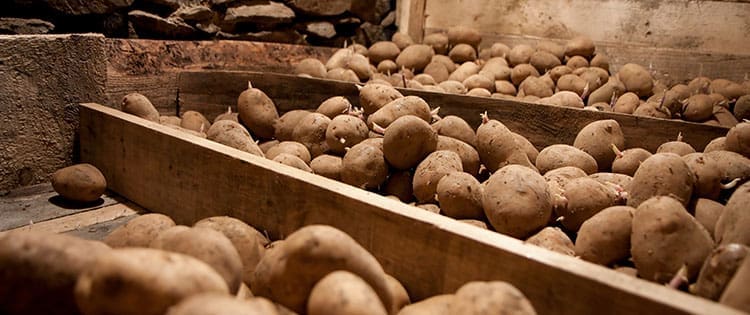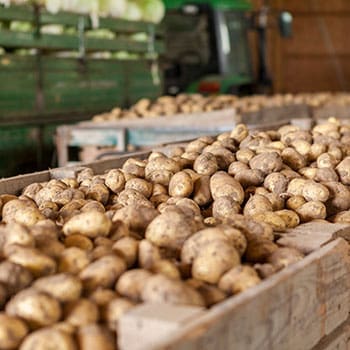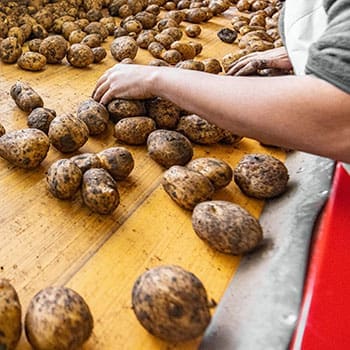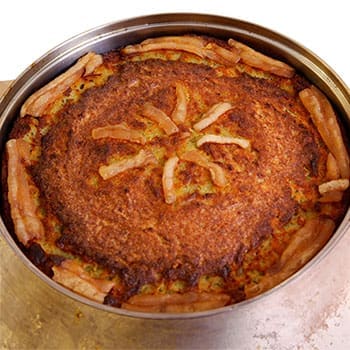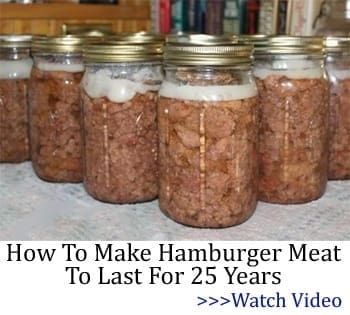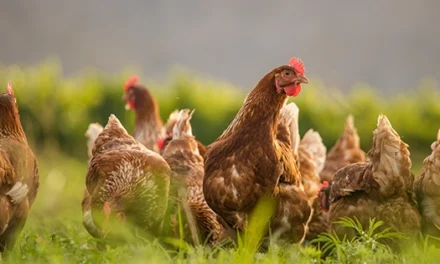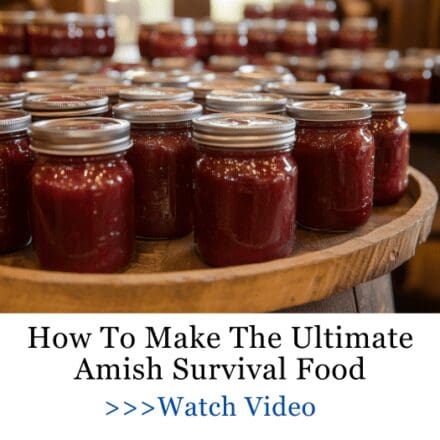Have you ever harvested potatoes on your homestead? It’s a feeling of pride, knowing that the fruits of your labor are about to become part of your next meal. Potatoes are such a staple in every kitchen, and the possibilities are endless. Whether it’s creamy mashed potatoes, hearty soups, fresh salads, or a flavorful stir-fry, potatoes are the perfect companion to any meal. But how long do potatoes last?
And here’s the big question: will your potato harvest last throughout the season? How can you make sure they stay fresh for as long as possible? Keep on reading today’s article to get all your curious queries answered!
Key Factors Affecting Potato Shelf Life
A few factors can greatly affect how long your potatoes stay fresh. Let’s examine these factors and discover how they can help extend the life of your harvest.
Storage Temperature

Let’s talk about temperature. Potatoes do best in cool, not cold, conditions. Aim for a storage room temperature between 45°F and 50°F or about 7°C to 10°C. If you’ve got a spare garage, that could be a perfect spot for your potatoes. Or a basement with no heat? Even better!
The thing about potatoes is that they don’t handle heat well; if it gets too warm, they’ll start sprouting. On the other hand, if it gets too cold, as we mentioned earlier, they can turn sugary and lose their flavor. So, finding that perfect temperature is really important for keeping your potatoes in their best shape.
Light Exposure
Potatoes aren’t fans of light. They prefer staying in the dark, so it’s best not to store them in direct sunlight. Why? Long exposure to light can cause them to turn green, thanks to the production of solanine. While a small amount won’t harm you, consuming too much can be dangerous. Store your potatoes in a cool, dark place to keep them fresh and safe.
Humidity Levels
Potatoes like a bit of humidity, but not too much. If the air is too dry, they’ll lose moisture, while high humidity can encourage mold growth and cause them to rot. The ideal humidity level for storing potatoes is around 90-95%. A place with good airflow can help maintain this balance.
Storage Tips To Make Potato Shelf Life Longer
Imagine you’ve just harvested a huge batch of potatoes, but now you’re wondering where and how to store them. Don’t stress—we’ve got you covered with plenty of tips to keep your potatoes in top shape for maximum potato shelf life.
-
Choose the Right Storage Containers

When storing potatoes, the right container can make all the difference. Avoid plastic bags, which trap moisture and promote rot. Instead, use breathable containers like burlap sacks, cardboard boxes, or mesh bags. These allow air to circulate around the potatoes, keeping them cool and dry.
-
Decide Optimal Storage Locations
Now that you’ve got the right containers, it’s time to think about where to store them. Remember, potatoes thrive in cool, dark, and dry environments, so avoid places like the fridge or sunny windowsills.
The perfect storage spot? A basement, cellar, or pantry where the temperature stays between 40-50°F. Moreover, if you’re short on space, a closet or cupboard works as long as it’s not near any heat sources like stoves or ovens.
-
Avoid Storing Potatoes with Onions
When storing onions and potatoes, it’s easy to toss them in the same bin or corner, right? But did you know that these two actually don’t get along well when stored together? Onions release gases that can cause potatoes to spoil faster, making them soft and mushy. To keep both of them fresh for longer, it’s best to store them separately.
-
Regularly Inspect Potatoes

It’s a good idea to check your potatoes every so often to make sure they stay in good shape. Even with the best storage practices, one rotten potato can start affecting the others. Keep an eye out for any soft spots, sprouting, or signs of mold. If you find a bad one, remove it right away to prevent it from spreading to the rest.
-
Don’t Wash Before Storing
While it might be tempting to clean your freshly harvested potatoes before storing them, it’s best to resist. Washing potatoes before storage can introduce moisture, leading to mold or rot. Instead, brush off any dirt gently with your hands or a soft brush. This way, your potatoes stay dry and less likely to spoil. Only wash them just before you’re ready to cook them.
Why Should I Care So Much About How Long Do Potatoes Last?
Caring about how long potatoes last is important, especially if you want to start a homestead or you already have one. Potatoes are a staple food, and storing them properly saves time and money. If you know how to store them right, you can rely on them year-round. Proper storage means you’ll always have a dependable food source, even in tough times. You have to implement strict food safety rules to keep your pantry safe.
Around your homestead, potatoes are useful in many ways. You can grow them in your garden or raised beds. They’re easy to store in a root cellar, too. Potatoes can be used in a wide variety of dishes like mashed potatoes, potato soup, or fries. I found this guide that has several long-lasting recipes that might be helpful.
You can also make potato-based products, such as potato flour or chips. Plus, the peels and scraps are great for feeding chickens or other livestock.
Related: Strange Ways to Grow Potatoes In a Tiny Space
Native Americans used potatoes not just as food but for medicine, too. For example, they made potato poultices to treat burns and bruises. They placed potato slices on foreheads to relieve headaches. Potato juice was also used to ease stomach problems and aid digestion.
In a survival situation where medical supplies might be scarce, knowing these kinds of old-school remedies could make all the difference. This guide will show you how to treat common ailments and even more serious health issues when modern healthcare is unavailable.
During the Civil War and the Great Depression, potatoes were a lifesaver. They were cheap, filling, and could be cooked in many ways. People often boiled or mashed potatoes for a simple, hearty meal. Potato stew was common, especially with whatever meat or vegetables were available. Potato soup was another go-to meal. It was easy to make and could be stretched by adding onions, flour, or leftover bones. People also fried potatoes or made potato pancakes. These meals were cheap and could feed a family when times were tough.
Potatoes were essential during these hard times because they’re nutritious, easy to grow and store well. They helped provide a steady supply of food when other resources were scarce.
Potato Cake Recipe: 25 Years Shelf-Life 
If you’ve got some potatoes lying around and want a recipe that’s simple, filling, and lasts a while, potato cakes are a great choice. This recipe is actually from my grandma, who used to make it during the Great Depression. She said it was a lifesaver back then because it used cheap, basic ingredients but still kept everyone full.
They’re super easy to make, don’t require anything fancy, and store really well. You can keep them in the fridge for a few days or freeze them for months. Plus, if you’re thinking even longer-term, you can dehydrate or freeze-dry them for later. Let me walk you through how to make them and how to store them.
First, grab four medium potatoes, peel them, and boil them in salted water until they’re soft. Grandma always said to save the water if you could, to use it for soup or bread-making later. Once the potatoes are cooked, drain them and mash them while they’re still warm.
Let them cool a bit before adding the rest of the ingredients. While they cool, chop up a small onion as fine as you can. Then mix the mashed potatoes with the onion, half a cup of flour, one egg (if you have it), and a pinch of salt and pepper. Stir everything together until you get a soft dough. If it’s sticky, just add a little more flour until it’s easy to handle.
Related: How To Grow An Endless Supply Of Potatoes
Next, shape the dough into patties about three to four inches wide and half an inch thick. Grandma would fry them up in a skillet with lard, but you can use butter or oil if that’s what you have. Heat your skillet over medium heat and fry the patties for about three to four minutes on each side until they’re golden and crispy. Once they’re done, let them cool on a rack so they don’t get soggy.
Now, let’s talk about storage. If you want to eat them within a few days, just store them in an airtight container in the fridge. They’ll last four to five days like this. For longer storage, freeze them. Lay the cakes flat on a baking sheet and freeze them first so they don’t stick together, then transfer them to a freezer bag or container. They’ll stay good in the freezer for up to three months.
If you’re looking for even longer storage, you can dehydrate the cakes. Once fully dried, they can last six to twelve months if you store them in an airtight container in a cool, dry place. And if you’re lucky enough to have a freeze-dryer, you can freeze-dry them. Vacuum-seal the cakes in Mylar bags with oxygen absorbers, and they’ll last up to 25 years. Grandma would’ve been thrilled to have that kind of technology back in her day!
Related: DIY Potato Tower
Frequently Asked Questions About Potato Shelf Life
1. How Long Do Cooked Potatoes Last?
Cooked potatoes can last 3 to 4 days in the fridge if you store them in an airtight container to keep their nutrients intact. Just be sure to check for any signs of spoilage, like an off smell or a weird texture. If you notice any, it’s best to toss them out to stay on the safe side.
2. Can I Eat Sprouted Potatoes?
Yes, you can eat sprouted potatoes as long as the sprouts are small and the potato is still firm to the touch. Just make sure to remove the sprouts and any green areas since they can contain solanine, a potentially harmful compound. Furthermore, if the potato is soft, wrinkled, or has a strong odor, consider disposing of it.
3. How Long Do Potatoes Last?
If you store potatoes the right way, they can last a long time. In a cool, dark, and well-ventilated spot like a basement or root cellar, they’ll keep for 2-3 months. The temperature should stay between 45–55°F. If you can maintain steady humidity at 85–95%, they can last even longer—up to 6-8 months.
To keep them fresh, store them away from light, which can make them turn green. Don’t put them near onions either, since onions release gases that make potatoes sprout or spoil faster. Check your potatoes often and get rid of any that are sprouting or rotting so they don’t ruin the rest.
4. How Long Do Potatoes Last In The Fridge?
On average, raw potatoes last between three to four months in the refrigerator. If you store in a freezer, you can do so up to one year, the average being 11 months.
5. How Do You Know If A Potato Went Bad?
You know if a potato went bad by looking at its exterior. If you notice dark spots and the texture is mushy or soft, the potatoes need to be thrown away. Usually, the first sign to look for that potatoes are starting to go bad is a foul odor. Cooked potatoes sometimes spoil without noticeable signs.
6. Can I Get Sick Off Of Bad Potatoes?
Yes. You can get sick off of bad potatoes because of the high levels of solanine present. Even if you do follow all safety guidelines, potatoes end up developing high solanine levels when damaged or improperly stored. Children in particular are at a high risk of becoming ill when consuming potatoes with high solanine levels.
7. Are Soft Potatoes Safe To Eat?
When the potatoes are slightly soft, they are safe to eat. Look out for the presence of mold, blemishes, or spots. If so, investigate further since the potatoes might have gone bad. Slightly soft potatoes but not spoiled can be suitable for potato pancakes, soups, stews, and mashed. They are not great for baking.
Final Thoughts
Whether you’re storing your potatoes in a pantry, a root cellar, making a potato cake, or something else, it’s important for every homesteader to know how long potatoes last. They’re one of the most nutritious foods—and delicious if you ask me.
Storing them properly makes a big difference and helps them last longer. If you want to learn even more, you can watch this video that teaches you a very useful tip on how to keep your potatoes fresh for up to one year.
Just remember: no onions in the same spot, and give them a quick check regularly to catch any signs of spoilage. With a little care, your potatoes will be ready for all your favorite meals, no matter the season.
Happy homesteading!
Dutch Oven Recipes Cowboys Survived On
Cheap and Easy to Build Root Cellar in Your Own Backyard (Video)
Survival Bread To Make In An Emergency

